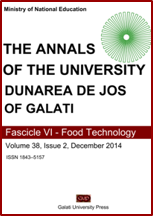Rheological behavior of pork Biceps femoris muscle influenced by injection-tumbling process and brine type
Abstract
The effect of tumbling time (1-9 h), injection rate (20, 30, 40, and 50 %) and kcarrageenan addition (0, 0.25, and 0.5 %) on the rheological characteristics of pork Biceps femoris muscle were assessed. The results of the creep-recovery tests were analyzed using Burger’s equation. Increasing tumbling time up to 9 h along with injection rate also increased compliance values and decreased viscosity. Kcarrageenan addition showed the occurrence of a more gel-like structure of the brine-meat system, causing further increase of the compliance and strain values.
Samples injected with brine were more elastic compared to those containing kcarrageenan. A longer mechanical treatment provided a softer like matrix. Mathematical modeling of creep-compliance data showed a decreasing tendency for viscosity values with k-carrageenan addition. Discrete retarded elastic compliance values increased when adding k-carrageenan to meat-brine system.
Addition of k-carrageenan did not affect the equilibrium compliance values.


